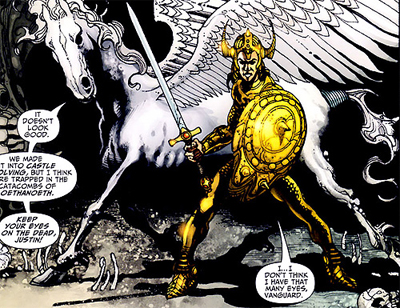
One of my favourite comic book authors is Grant Morrison. He writes with so much energy and creativity, such a sense of fun, that so many of his comics are a psychedelic thrill ride exploring so many crazy ideas. One of Morrison’s most ambitious projects was DC’s Seven Soldiers of Victory, seven interlocking miniseries about seven different DC heroes who independently fight against an invasion of demonic fairies known as the Sheeda.
One of these heroes is a reinvented version of the Shining Knight, a champion of King Arthur’s court who reawakens in modern times. While the original version of the Shining Knight was from the Dark Ages and the pseudo-historical King Arthur, Morrison’s version instead comes from a fantastical “ur-Arthur” thousands of years before recorded history. Basically, the archetypes of King Arthur and his champions appear over and over again in this world, each time in a different form.
This prehistoric fantasy Arthur first appears in Shining Knight #1, which retells the famous Taliesin poem “The Spoils of Annwn”: “before the spoils of Annwn woefully he sang, / And thenceforth till doom he shall remain a bard. / Thrice enough to fill Arthur’s ship we went into it; / Except seven, none returned from Castle Revolving.” In the comic, Arthur’s army is at war with the Sheeda, and they battle to the Sheeda’s capital of Castle Revolving to steal their enchanted cauldron which is the Castle’s heart. Of Arthur’s men, none but seven return.
Shining Knight #1 starts off powerfull and mythic: “From the far, unspeakable land of the Vampire Sun they came, from Eternal Summer’s End on Sheeda-Side….” It is clearly not some faux historical tale in the remnants of Rome nor a stiff and courtly Romance. It’s old myths, wild and fantastical. Sadly, beyond the basic premise of the poem (Arthur’s men go into Fairyland to steal the cauldron heart of Castle Revolving), Morrison is not especially interested in engaging with the original folktales.
It feels like he skimmed the poem, but never Welsh prose — didn’t actually take a look at the Mabinogian. Firstly, the fairies are called the “Sheeda” — a clear derivative from the Irish “Sidhe” — instead of the “Tylwyth Teg” or the “Fair Folk.” Merlin gets referenced as “royal were-dragon from Celtic mythology” whose name is also “Gwydion,” which is utter nonsense (Morrison’s earlier idea of Merlin being a renegade Sheeda sorcerer would have felt much more authentic). The warriors dress like knights, when having stranger, more primal costumes would suit the Welsh folklore and the pre-historic narrative far better. Morrison’s list of Arthur’s champions is especially telling:
“Against the Sheeda, Gawain, the Silent Knight, attended by his wondrous hawks. And Lancelot, defender of the faith so long with such a broken heart. Mighty Caradoc, who loved peace most of all. Peredur, blinded by the light of the Holy Cup, yet possessed of celestial senses unknown to ordinary men. Bors, the Laughing Knight. And Galahad next. Galahad, the Giant Killer. The Perfect Knight. Warriors all, of the Shattered Table. But first… Lancelot.”
The idea that each knight has his own special power or trait is straight out of “Culhwch & Olwen,” of course. There are some other Welsh touches here. Gawain’s hawks probably reference his Welsh name, Gwalchmai (“Hawk of May”). “Peredur” is the Welsh name for Percival, the star of one of the Welsh Romances. The name “Caradoc” is very Welsh, though I haven’t heard of any prominent members of Arthur’s court called that. Olwen later shows up in the story.
However, in folklore Gwalchmai’s defining trait is his politeness, whereas this Gawain is silent. This Peredur is obsessed with the Holy Grail (a Romance invention). Perhaps most prominently, Lancelot, Bors, and Galahad were all creations of the French Romances, and thus utterly alien to Welsh myths. Conversely, the comic has no references to Cai or Bedwyr, Arthur’s most devoted companions in the Welsh cycle.
Morrison’s Shining Knight is a lot of fun, and its description of Castle Revolving and the epic raid has a lot of strength to it. Certainly it captures a lot of the fantastical spirit of Welsh folklore, that is sadly missing in most Arthurian retellings. That said, it would have been more compelling and much more mythic if it engaged more with the original Welsh folktales. If the scene were to feature a fully Welsh retinue of warriors, I would describe them thusly:
“Against the Teg, Cai, defender of the faith so long with such a broken heart. Owain, attended by his black lion and his wondrous ravens. Mighty Bedwyr One-Handed, wielder of the Living Spear. Gwalchmai the Golden-Tongued, whose strength waxed and waned with the sun. Geraint the Seafarer. Menw, son of Three-Cries, the Warrior-Wizard. And Peredur next. Peredur, the Monster Killer. The Perfect Champion. Warriors all, of the Shattered Table. But first… Cai.”

